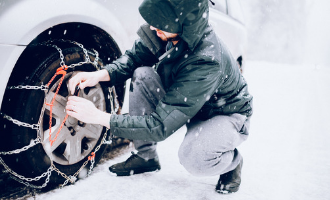Understanding Colorado’s Traction Laws
 As every Coloradoan knows, our great state has gorgeous scenery throughout the entire year. Even when things turn cold and many areas are blanketed in snow, the effect is breathtaking. That’s probably why a lot of people love calling Colorado their home and why many residents and visitors love to take road trips, no matter the season.
As every Coloradoan knows, our great state has gorgeous scenery throughout the entire year. Even when things turn cold and many areas are blanketed in snow, the effect is breathtaking. That’s probably why a lot of people love calling Colorado their home and why many residents and visitors love to take road trips, no matter the season.
Of course, traffic safety has a lot to do with knowing how to traverse roads during the winter season and beyond. This is why Colorado has traction laws that you must follow. Today, we’re going to go over a few simple facts about these laws so that you can fully understand what they’re all about.
The Need for Proper Traction
As you’re probably aware, traction basically refers to the grip that your tires have on the road in any given situation. You don’t have to spend too much time driving around in Colorado to realize why traction is so important. This is especially true when the winter season hits and you are forced to deal with snow and ice on the road. The last thing you want to do is start slipping and sliding around busy streets, lose control on one of Colorado’s numerous mountain passes, or encounter issues on I-70 as you’re heading to the mountains for a day of skiing or snowboarding.
What the Traction Laws Say
The state’s traction laws go into effect whenever Colorado’s roadways are impacted by adverse conditions. This is obviously due to the fact that we have snow and ice on the road during this period of time. What you might not realize is that there are two different traction laws on the books. The first is simply called the Traction Law, also known as Code 15, where all vehicles must be equipped with snow tires, tires with a mud/snow designation, or four-wheel drive/all-wheel drive. All tires, regardless of mud/snow designation or if they’re affixed to an AWD vehicle, must meet the minimum requirement of 1/8th-inch tread.
The second law is called the Passenger Vehicle Chain Law, which is also known as Code 16. This is used during severe winter weather and requires that all vehicles have chains or an alternative traction device on their tires. It is typically used as the last safety measure before a highway is closed.
Penalties If You Break the Law
If you ignore either of Colorado’s two traction laws whenever they are in effect, you could face a fine of more than $130. But if you block the roadway due to faulty or inadequate equipment while traction laws are in effect, you might be on the hook for more than $650. Either way, it’s simply better to always follow the laws whenever they are in effect.
How to Avoid Breaking the Law
The easiest way to stay compliant when traction laws are in effect is to equip your vehicle with snow tires that are rated for all weather conditions and ensure that you maintain the proper amount of tread. The Passenger Vehicle Chain Law can be a little trickier because you don’t know when the weather may become severe enough for it to take effect. While it’s true that this law doesn’t go into effect too often in most areas, it’s always better to be safe than sorry. For this reason, you should always carry a full set of tire chains or alternative traction control devices somewhere in your vehicle throughout the entire winter season so that you’ll be ready at all times.
Even when you understand Colorado’s traction laws and follow them perfectly, you may find yourself involved in an accident on the road. If you’ve been injured by the negligence or carelessness of another driver, don’t hesitate to contact the qualified attorneys at Mintz Law Firm for a free evaluation.
